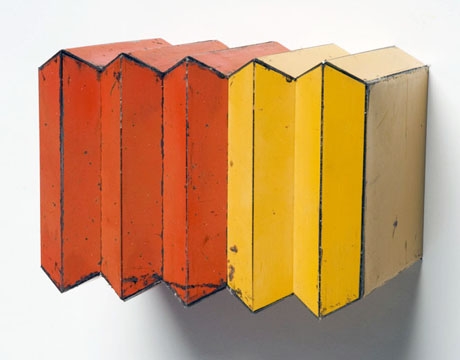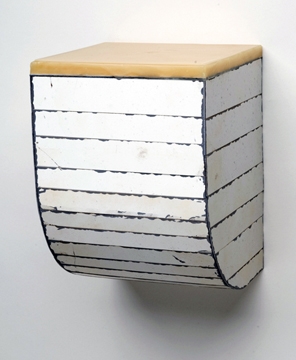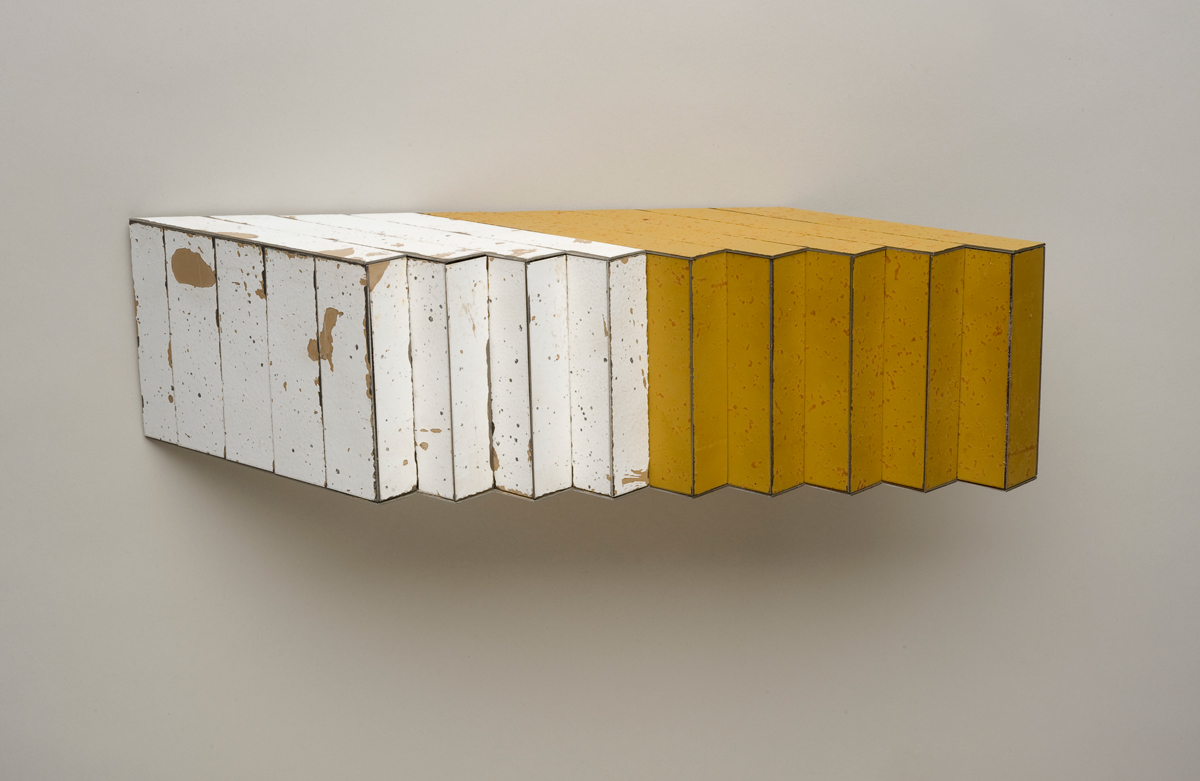Surfaced Forms - Sculpture Magazine, March 2014
"Ted Larsen's sculptures are intimate and self-contained. His simple geometric forms resemble found objects, suggesting a past, reminiscent of something previously encountered. Although understated, the objects demand consideration. Proximity encourages examination, which then revels the complexity of these nuanced sculptures.
Born in 1964, Larsen has lived in New Mexico since age fifteen. Currently he maintains a studio in Santa Fe and exhibits locally as well as at galleries in Miami, New York City, and Philadelphia. Unlike many of the artists associated with New Mexico, who are influenced by the state’s monumental and dramatic landscape, Larsen turns inward to find direction. His work appears hyper-personal, like notes in a diary, lyrically brought into form and enhanced by a poetic sensibility.
There is a soft geometry to Larsen’s sculptures. Constructed with the hand and orientation of a craftsman, the shapes are gentle, while at the same time, direct. Fabrication begins with Baltic birch, a marine-grade plywood, cut into forms that are then glued and screwed together. The intense focus of this process results in an object that could be viewed as a completed sculpture. “Consider it stacking beauty. Subversively layering beauty and denying beauty at once” is how Larsen describes his method.
While his forms are finely built with a sculptor’s intent, the surfaces reveal the eye of a painter. An intriguing aspect of the work is that the outer layer is not actually painted, but is instead salvaged reclaimed steel scrap. His sculptures give the impression that they have been effortlessly created. But in fact, the opposite is the case. Describing the initial stages of his fabrication and the way he finds his “palette”, Larsen explains,
“I go the salvage yards (salvage steel is sold as a commodity, just like new steel) to look for material. Sometimes I find things, sometimes not. Sometimes I score and I find really good stuff and a lot of it. Most of the time I might find one or two pieces that work.
I bring a painter's eye to the whole process. I am indeed looking for a palette, greens, blues, yellows, different types of each. They have to have a certain quality, not too raw, not to clean. There is a lot of processing involved to get the materials at the yards. I only purchase what I can use; the rest of the parts (and there are is a lot) I leave behind.
At the studio the processing continues. There I use different tools depending on the processing steps.
Different tools depending on the place: rough cutting at the yard and fine cutting at the studio. I clean everything up and I have several hundred pounds of steel at any one time. The front side of the work- gathering and processing -takes a very long time. It is very hard work, and it is dangerous work.”
In viewing these sculptures, there is no hint of the danger involved in making them. The means to the end are hidden from view. The essence of the work, the focused consideration seen in every detail, denies the aggressive energy needed at the beginning of each project. There is a great deal of illusion in Larsen’s work; never do they disclose all of their secrets.
Beyond skill and ingenuity, it is the refined sensibility, the balance between form and surface that quickens these sculptures. With this most restrained approach, Larsen builds objects that are seductively beautiful, transforming discarded material into considered works of art. Few artists do so much with so little.
In “Endless Form”, an accordion construction surfaced with just two colors, the geometry is basic and repetitive. One half of the work is orange, the other yellow. All aspects of this piece are perfectly calibrated. The fine-tuning of shape and skin demonstrates the artist’s dexterity. The work has a natural patina, suggesting age. To this artist, three-dimensional forms are what a stretched canvas is to a painter, a foundation on which he builds his vision. Larsen has created several variations of this sculpture.
While “Endless Form” is about surface, shape, line, and volume, “Return Policy” is a different type of effort. A simple white shape, slightly off square, floats in front of a cluster of odd metal strips. This is an unusual object, a construction that might have a function, currently or in another time. “Endless Form” pulls you in, inviting speculation. Yet the sculpture is simply a work of art, secured to a wall, nothing more.
Larsen’s “Step a Little Closer” could easily be mistaken for something found. The structure appears to be a machine part. Edges of the sculpture are raw and worn, seemingly affected by time or use. Every aspect of this piece suggests an application. But of course this is not something found, nor did it ever function. Larsen completely fabricated “Step a Little Closer”, an artwork birthed from his imagination and intuition. .
Recently Larsen’s sculptures have become more complex. Earlier pieces were mostly self-contained volumes, defined and enhanced by surface. Several newer works seem to expand outward beyond a single primary element. In “Close Distance”, Larsen composes a mini-exhibition of six forms on a wall, connected by multi-colored linear parts. Each piece is different from the other, yet the grouping seems appropriate. A subtle tension exists within the overall sculpture as the viewer is asked to consider the similarities and differences presented.
“Here and There” is another sculpture that transcends the underpinnings of the artist’s previous works. In the past, Larsen’s forms could be defined as either floor-mounted or wall-mounted. “Here and There” is curiously both. This construction’s two halves are variations of each other, related in overall shape, but slightly different in size and color treatment. Yet the parts read differently - the wall backs one creating a 2 dimensional image and the other projects into space as a 3 dimensional object. This juxtaposition of placement sets up an unexpected visual dynamic.
Larsen rejects conventions often embraced by sculptors today. He has no interest in esoteric costly materials and does not aspire to create monumental works that dwarf human scale or dominate a landscape. It is the humble and the overlooked that motivates this artist. Using discarded scraps, Ted Larsen consistently builds exquisite sculpture that invites inquiry and thoughtful reflection."



